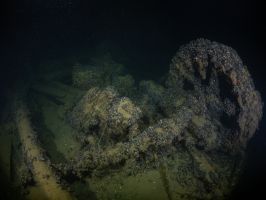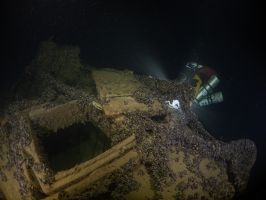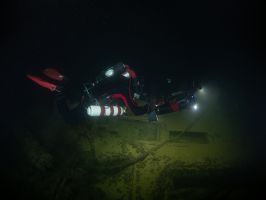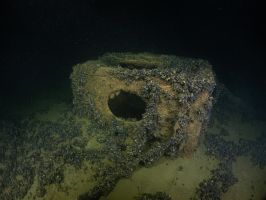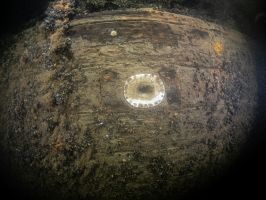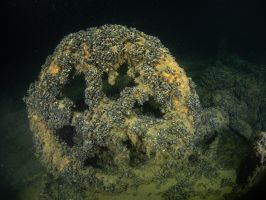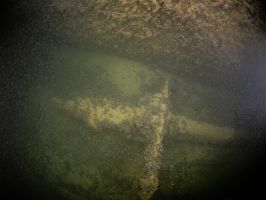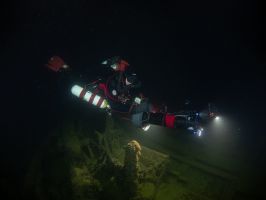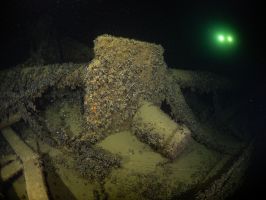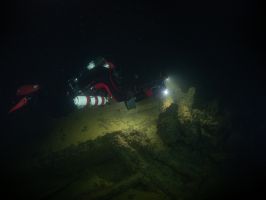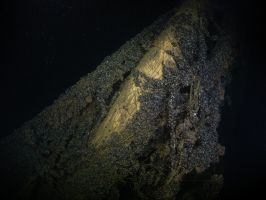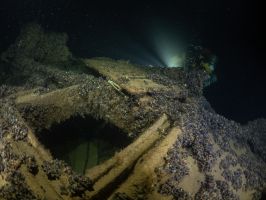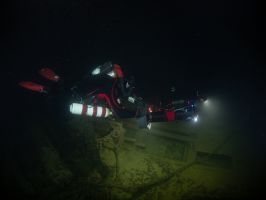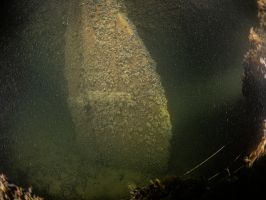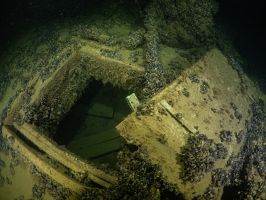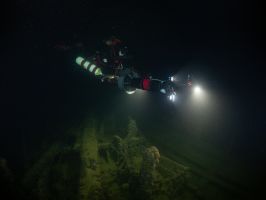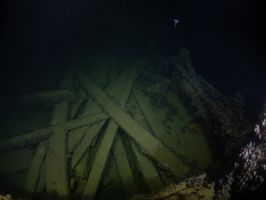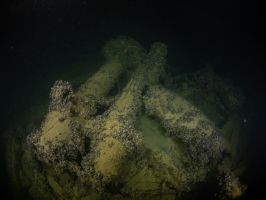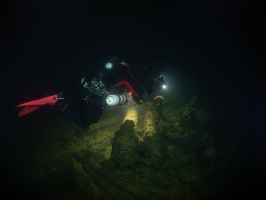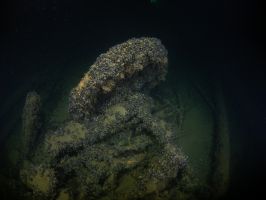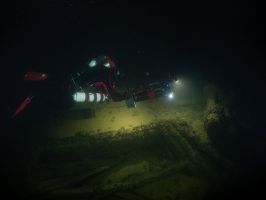Diving on the wreck site
The wreck lies on the keel. The depth at the seabed is 65 meters, with the deck at 60 meters. The wreck is covered in some fishing nets and fishing lines. In the central part of the wooden deck, there are fragments of the anchor windlass, including large wheels, shafts, and rollers for winding the rope. On the stern deck, there is a low superstructure with elliptical openings. Behind this superstructure, at the very stern, there are detached doors with brass hinges. Under the stern is a wooden rudder blade. At the bow area, there is a 10-meter-long section of the mast sticking up from the deck. It is wrapped in nets, but where the nets are pulled away, the thick growth rings of the wood are visible. The mast is broken, with the remaining part lying on the seabed, moved away from the starboard side. Near the stern along the starboard side is another section of the mast, almost touching the first. The wreck is a beautiful wooden sailing ship, and diving on it provides great satisfaction from interacting with such a well-preserved example of this type of unit. However, strong currents that occasionally occur can make diving difficult and sometimes prevent the exploration of this beautiful wreck. Diving at this site requires permission from the Maritime Office in Gdynia.
Story
The wreck of the sailing ship near Hel
There are many wrecks around the Hel Peninsula, most of which are available for recreational diving. However, diving on some wrecks, due to their high scientific value and the presence of numerous movable artifacts, requires special permission. Among such wrecks is a wooden sailing ship discovered early this century to the east of Hel. The wreck lies at a depth of 63 meters and has not yet been fully explored. Over the past 20 years, several attempts have been made to determine the chronology and condition of the object. The first inspection of the wreck was carried out in cooperation with the National Maritime Museum by divers from the Baltic Wreck Society. In 2008, they recovered a single yufers (a type of lead ballast) with a piece of rope and a jug with a broken handle. In 2010, divers from the Baltictech Association recovered a small deck bell—unfortunately, without the ship's name.
After 14 years, in April 2024, a team of divers from the Diveland Diving Support Foundation and historians from GEMO, in collaboration with the NMM, undertook the task of creating the first detailed documentation of the wreck and reassessing its condition. Based on the collected film, photographic, and three-dimensional model documentation, it was established that the wreck is 30 meters long and approximately 5 meters wide. It rests evenly on the keel on a silty seabed and rises about 4 meters above the bottom. Fragments of broken masts lie in front of the bow. The highest point is the broken front mast, approximately 10 meters high, with nets hanging from it. The hull consists of planks arranged edge to edge. On the starboard side, there is a round opening reinforced with metal plating, likely used for draining water from the deck. Along the sides, there are remains of railings. The bow features a broken bowsprit and an anchor windlass covered with nets. In the central part of the deck, there is a jumble of boards (possibly remains of a lifeboat stand?), a socket for the second mast, a skylight, remains of shafts, and wheels of a mechanical winch. The stern features a low superstructure with a skylight and hatches. The only remaining items from the companionway are detached doors with hinges. The deck is strewn with individual blocks. The hull interior is filled with bottom sediment. Near the transom, there is a rudder column with visible steering gear. The steering wheel itself has not survived today. Below the transom, under nets, there is a high rudder blade embedded deep in the seabed.
Due to its size and number of masts, the wreck can be considered a two-masted sailing ship, resembling a schooner. Such vessels, particularly popular in the 19th century, were used until the outbreak of World War I. Smaller schooners used for coastal and Baltic navigation were primarily built in Scottish shipyards. Larger, multi-masted schooners used for ocean voyages were mostly produced in North America.
The Scottish origin of the ship is indirectly suggested by a jug recovered years ago, made of cream-colored stoneware and covered with salt glaze on the upper part. At the bottom of the vessel, there is a stamp with the name of the manufacturer H. Kennedy Barrowfield Pottery Glasgow, which operated from 1866 to 1929 (under this name until 1890). On the jug's side, there is the name DAVID MITCHEL Grocer & Wine Merchant GRAY STREET BROUGHTY FERRY. According to Scottish address books, David Mitchel—wine merchant and spirits distributor—conducted his business at Gray Street in Broughty Ferry (now a district of Dundee) between 1874 and 1875. The jug on the ship might have been part of the cargo or equipment for the crew or passengers. Stoneware vessels were used for storage and transportation, and due to their durability, jugs were often washed and reused for several years. The presence of David Mitchel's jug suggests that the ship sank in the late 1870s or the 1880s. The name and owner of the ship remain a mystery.
Text: Anna Rembisz-Lubiejewska
Technical specifications
Length : about 35 m
Width: about 7 m
Depth above the seabed: about 6 m
Text by: Kamil Stankiewicz
Translation: Szymon Rydzewski
If you have additional info on the ship or would like to correct the Information on the site - please contact us.



